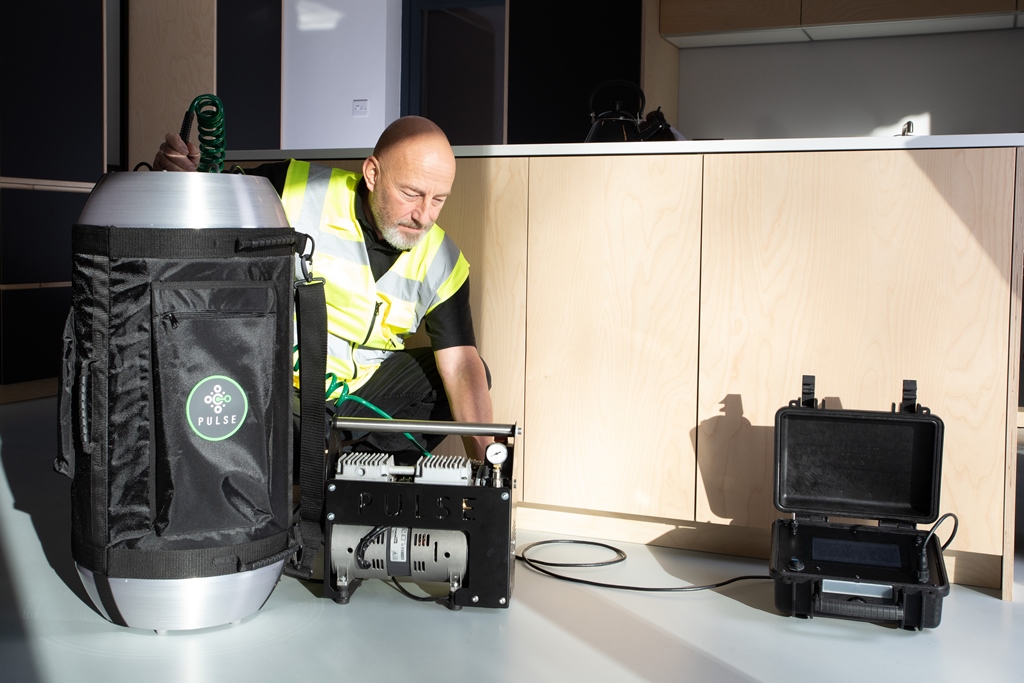Air Tightness Testing for Energy Efficiency in New Constructions
Our air tightness testing services are designed specifically for construction firms and developers needing to meet building regulations. Our Essential Green Skills team provides reliable and efficient air leakage tests across mainland England, ensuring your projects are compliant and energy-efficient.
Schedule an Air Tightness Test
Required On All New Build Properties
The release of the new part L standards in Building Regulations on 15th June 2022 means that every new build property now requires an airtightness test!
Under Building Regulations Approved Document L, you will require an air tightness test if you are:
- Building any new build residential dwelling(s)
- Building any new build commercial space(s)
Air tightness tests are not required on:
- Conversion projects
- Existing dwellings
- Extensions

-
Adhering to Building Regulations ‘Part L’
Minimising or eliminating air leakage is a legal obligation when constructing new domestic properties and other buildings. Building regulations were updated in June 2022, further tightening the requirements for energy efficiency in buildings. This includes more stringent standards for air tightness, with all new homes now required to comply with ‘Part L’. This means that a higher percentage of new houses must undergo air tightness testing – also known as air leakage testing or air permeability testing – to ensure they meet these updated standards. The new regulations also emphasise the importance of reducing carbon emissions and improving overall energy performance in both residential and commercial buildings.
-
What is Air Tightness Testing?
Air tightness testing is a procedure to identify unwanted drafts and uncontrolled airflow in houses and other buildings. Excessive air leakage leads to heat loss and higher CO2 emissions. Reducing CO2 emissions is the primary goal of ‘Part L’ of the updated building regulations.
-
Air Permeability Testing and the Building Regulations
Air infiltration affects all buildings to some extent, caused by holes, gaps, and cracks, which can worsen under adverse weather conditions. As a construction firm or developer, it is your legal duty, as outlined by building regulations, to minimise this air movement and the resulting energy loss.
When Do I Need An Air Tightness Test?
Testing is typically performed post-second fix.
Before the test, ensure the following:
-
All major penetrations to walls and floors are completed.
-
All service penetrations are sealed.
-
Trickle vents are installed.
-
Loft access hatch is in place.
-
Plumbing is complete with water in the traps.
-
Seals are fitted on external doors.
-
Electrical outlets are fitted.
Preparation Checklist
Additionally, ensure the following preparations are made before the agreed test date to avoid unnecessary delays or additional test fees:
-
240v 50Hz mains power is available within or close to the dwellings.
-
Provide working drawings and target scores for air tests if not completing SAP Calculations.
-
Windows and external doors must be installed, dry, glazed, and closed.
-
Walls, floors, and ceilings must be completed.
-
Skirting boards, electrical sockets, light switches, kitchen units, and bathroom suites must be fitted.
-
Dwellings should be empty and tidy where possible.
-
Loft hatches/eaves cupboards should be fitted and draft stripped (not taped).
-
Drainage traps should be filled with water.
-
Mastic sealant should be applied to doors, windows, skirting, and services penetrating the building fabric.
-
Standard test equipment fits openings up to 1000mm x 2400mm. Notify if no external doorway is available within these dimensions.
Importance of Testing for Air Tightness
Testing for air tightness is crucial for housing developers to ensure dwellings are energy-efficient and comfortable. It measures air leakage, which impacts:
-
Dampness and rising damp
-
Excessive heat loss
-
Increased heating and energy bills
-
Drafts
-
Occupant comfort
Neglecting air tightness can lead to unsatisfactory living conditions, affecting the marketability of your properties. Moreover, non-compliance with Part L1A of Building Regulations can result in significant fines and legal actions. Adhering to these standards is essential to obtain the necessary pass certificate and avoid these consequences.
Frequently Asked Questions
-
What is good air tightness?
Good air tightness refers to the ability of a building to minimise unwanted air leakage through its structure, which can include gaps, cracks, and openings. High levels of air tightness ensure that a building is more energy-efficient, as it reduces heat loss, prevents drafts, and maintains a consistent indoor environment. This contributes to lower energy bills, improved occupant comfort, and a reduced carbon footprint.
-
What is a good air tightness test result?
A good air tightness test result is typically measured by the air permeability rate, expressed in cubic meters per hour per square meter of building envelope area (m³/h·m²) at a pressure difference of 50 Pascals (Pa). For new build residential properties in the UK, a result of 5 m³/h·m² or lower is often considered good and compliant with current Building Regulations. However, for highly energy-efficient buildings, such as those aiming for Passivhaus standards, the target is much lower, around 0.6 m³/h·m².
-
How do you improve air tightness?
Improving air tightness involves several strategies:
- Sealing Gaps and Cracks: Use mastic sealants, foam, or caulking to seal gaps around windows, doors, pipes, and electrical outlets.
- Installing Draft Excluders: Apply draft excluders to doors and windows to prevent air leakage.
- Using Airtight Membranes: Install airtight membranes and tapes in walls, roofs, and floors to create a continuous air barrier.
- Ensuring Proper Installation: Ensure all building components, such as windows, doors, and ventilation systems, are installed correctly and sealed properly.
- Regular Maintenance: Inspect and maintain seals and insulation regularly to ensure they remain effective over time.
-
What are the air tightness requirements in the UK?
In the UK, air tightness requirements for new buildings are outlined in the Building Regulations Approved Document L. As of the latest updates in June 2022:
- New Build Residential Dwellings: Must achieve an air permeability rate of 10 m³/h·m² or lower at 50 Pascals. However, many developers aim for a more stringent target of 5 m³/h·m² to ensure better energy efficiency.
- Non-Domestic Buildings: Air tightness targets can vary depending on the building's design and use, but similar principles apply, aiming for low air permeability to improve energy efficiency.
These standards are part of broader efforts to enhance the energy performance and sustainability of buildings in the UK.

